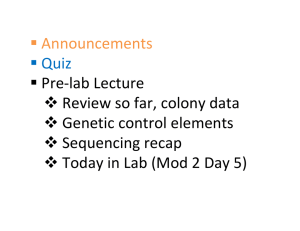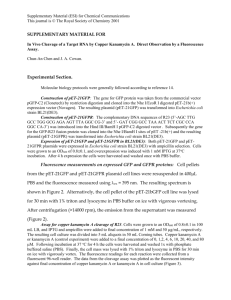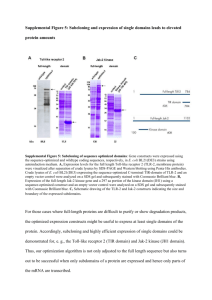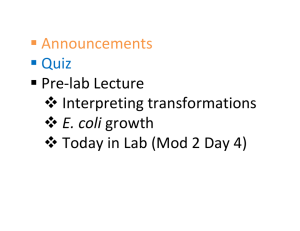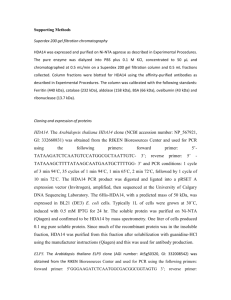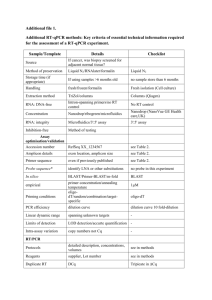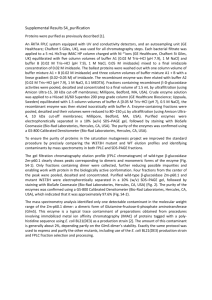One Shot BL21(DE3) BL21(DE3)pLysS
advertisement
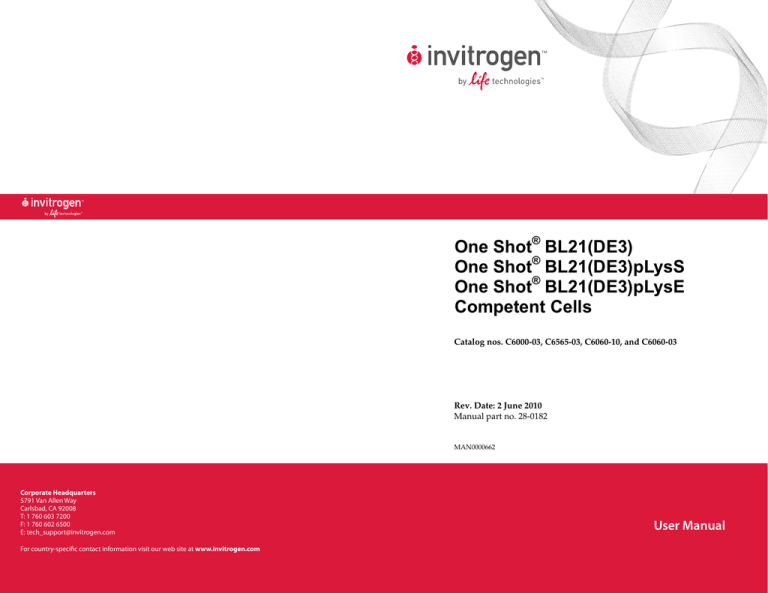
One Shot® BL21(DE3) One Shot® BL21(DE3)pLysS One Shot® BL21(DE3)pLysE Competent Cells Catalog nos. C6000-03, C6565-03, C6060-10, and C6060-03 Rev. Date: 2 June 2010 Manual part no. 28-0182 MAN0000662 Corporate Headquarters 5791 Van Allen Way Carlsbad, CA 92008 T: 1 760 603 7200 F: 1 760 602 6500 E: tech_support@invitrogen.com For country-specific contact information visit our web site at www.invitrogen.com User Manual ii Table of Contents About the Kit............................................................................................................. 1 Basic Transformation Procedure............................................................................. 5 Expression Guidelines.............................................................................................. 7 Testing Transformation Efficiency ....................................................................... 11 Technical Support................................................................................................... 12 Purchaser Notification ........................................................................................... 14 iii iv About the Kit Available Kits Item BL21(DE3) BL21(DE3)pLysS BL21(DE3)pLysE The table below lists the kits covered by this manual. The contents of each kit are listed below. Reactions Transformation Efficiency 20 Catalog no. 8 C6000-03 8 1 × 10 cfu/μg 10 1 × 10 cfu/μg C6060-10 20 1 × 108 cfu/μg C6060-03 7 1 × 10 cfu/μg 20 C6565-03 Shipping/ Storage Each One Shot® kit is shipped on dry ice. Upon receipt, store at –80°C. Kit Contents The table below describes the items included in each of the One Shot® chemically competent E. coli kits described above. Store at –80°C. Item Composition Amount SOC Medium (store at room temperature or 4°C) 2% Tryptone, 0.5% Yeast Extract, 10 mM NaCl, 2.5 mM KCl, 10 mM MgCl2, 10 mM MgSO4, 20 mM glucose 6 mL Chemically competent cells pUC19 Control DNA — 11 × 50 μL (10 reaction kits) OR 21 × 50 μL (20 reaction kits) 10 pg/μL in 5 mM Tris-HCl, 50 μL 0.5 mM EDTA, pH 8 Continued on next page 1 About the Kit, Continued Genotypes BL21(DE3): F- ompT hsdSB (rB-mB-) gal dcm (DE3) BL21(DE3)pLysS: F- ompT hsdSB (rB-mB-) gal dcm (DE3) pLysS (CamR) BL21(DE3)pLysE: F- ompT hsdSB (rB-mB-) gal dcm (DE3) pLysE (CamR) The DE3 designation indicate the strains contain the DE3 lysogen that carries the gene for T7 RNA polymerase under control of the lacUV5 promoter. IPTG is required to induce expression of the T7 RNA polymerase. The three strains are E. coli B/r strains and do not contain the lon protease. They are also deficient in the outer membrane protease, OmpT. The lack of two key proteases reduces degradation of heterologous proteins expressed in the strains. BL21(DE3)pLysS and BL21(DE3)pLysE carry the pLysS and pLysE plasmids, respectively, which produce T7 lysozyme (see below). The BL21(DE3) strain does not carry a plasmid expressing T7 lysozyme. pLysS and pLysE The pLysS plasmid carried by the BL21(DE3)pLysS strain produces T7 lysozyme to reduce basal level expression of the gene of interest. pLysS confers resistance to chloramphenicol (CamR) and contains the p15A origin. This origin allows pLysS to be compatible with plasmids containing the ColE1 or pMB1 origin (i.e. pUC- or pBR322derived plasmids). The pLysE plasmid carried by the BL21(DE3)pLysE strain produces higher amounts of T7 lysozyme than pLysS to further reduce basal level expression of the gene of interest. Like pLysS, pLysE confers resistance to chloramphenicol (CamR) and contains the p15A origin for compatibility with plasmids containing the ColE1 or pMB1 origin. Continued on next page 2 About the Kit, Continued Expression of Heterologous Genes The BL21(DE3) strain is suitable for use in expressing nontoxic heterologous genes. Recombinant proteins are generally expressed at higher levels in BL21(DE3) cells than in BL21(DE3)pLysS or BL21(DE3)pLysE, but basal expression of heterologous genes is significantly higher in BL21(DE3) cells than in BL21(DE3)pLysS or BL21(DE3) pLysE cells as well. The BL21(DE3)pLysS and BL21(DE3)pLysE strains produce T7 lysozyme to reduce basal expression of heterologous genes. These two strains are recommended for use when expressing toxic genes. General Handling Important Be extremely gentle when working with competent cells. Competent cells are highly sensitive to changes in temperature and mechanical lysis caused by pipetting. Transformation should be started immediately after thawing the cells on ice. Mix the transformation reaction by swirling or tapping the tube gently, not by pipetting. BL21(DE3), BL21(DE3)pLysS, and BL21(DE3)pLysE One Shot® cells require IPTG to induce expression of the T7 RNA polymerase from the lacUV5 promoter. Continued on next page 3 About the Kit, Continued Product Specifications One Shot® BL21(DE3), BL21(DE3)pLysS, and BL21(DE3) pLysE cells are qualified based on the following criteria: 50 μL of competent cells are transformed with 10 pg of supercoiled pUC19 plasmid DNA. Transformed cultures are plated on LB plates containing 50 μg/mL ampicillin and the transformation efficiency is calculated. Test transformations are performed in triplicate. Transformation efficiency should be: • >1 × 108 cfu/μg DNA for BL21(DE3) cells • >1 × 108 cfu/μg DNA for BL21(DE3)pLysS cells • >1 × 107 cfu/μg DNA for BL21(DE3)pLysE cells Untransformed cells are plated on: Intended Use 4 • LB plates containing 50 μg/mL ampicillin to verify the absence of ampicillin resistant contamination. • LB plates as a lawn to verify the absence of phage contamination. • LB plates containing 34 μg/mL chloramphenicol for selection of pLysS or pLysE (for BL21(DE3)pLysS or BL21(DE3)pLysE, respectively) For research use only. Not intended for human or animal diagnostic or therapeutic uses. Basic Transformation Procedure Introduction A basic transformation protocol for BL21(DE3), BL21(DE3)pLysS, and BL21(DE3) pLysE cells is provided below. Proceed directly to expression using your own protocol once you have selected transformants. Please note that BL21(DE3), BL21(DE3)pLysS, and BL21(DE3)pLysE are designed to be used for expression, not cloning or subcloning. If you have questions about expression using BL21(DE3), BL21(DE3)pLysS, or BL21(DE3)pLysE cells, please see pages 7-10. Materials Supplied by the User • Plasmid DNA (ready for transformation) • 42°C water bath • 37°C shaking and non-shaking incubator • Ice bucket with ice • Spectrophotometer to measure optical density of the cell cultures • Microcentrifuge tube rack (optional) • Prepare LB agar plates containing the appropriate concentration of antibiotic (for plasmid selection). If you are using BL21(DE3)pLysS or BL21(DE3)pLysE, add 34 μg/mL chloramphenicol (for pLysS or pLysE selection) • Equilibrate a water bath to 42°C • Warm the vial of SOC medium to room temperature • Place the plates in a 37°C incubator to remove excess moisture (use two plates for each transformation) Before Starting Continued on next page 5 Basic Transformation Procedure, Continued Basic Transformation Procedure 1. Thaw one vial of One Shot® cells on ice per transformation. 2. Add 5–10 ng of DNA, in a volume of 1–5 μL to the cells and mix by tapping gently. Do not mix cells by pipetting. 3. Incubate the vial(s) on ice for 30 minutes. 4. Heat shock the cells by incubating the vial(s) for exactly 30 seconds in the 42°C water bath. Do not mix or shake. 5. Remove the vial(s) from the 42°C bath and quickly place on ice. 6. Add 250 μL of pre-warmed SOC medium to the vial(s). (SOC is a rich medium; use proper sterile technique to avoid contamination.) 7. Secure the vial(s) in a microcentrifuge rack with tape. Place the rack in a shaking incubator, and shake the vial(s) at 37°C for 1 hour at 225 rpm. 8. Plate two different volumes of the transformation reaction onto LB plates containing the appropriate antibiotic for plasmid selection. Include 34 μg/mL chloramphenicol if using BL21(DE3)pLysS or BL21(DE3)pLysE cells. Select two volumes ranging from 20–200 μL to ensure well-spaced colonies on at least one plate. The remaining transformation reaction may be stored at 4°C and plated out the next day, if needed. 9. Invert the plates and incubate at 37°C overnight. 10. Select transformants from the plates and culture as described on page 8. Note: Clones may exhibit differences in expression of heterologous genes. We recommend choosing 3–4 transformants when characterizing clones for protein expression. 6 Expression Guidelines MEND ION AT RECOM Introduction If you have an expression protocol for the plasmid that you are working with, we recommend that you use your own protocol. This section provides some general guide-lines for the use of T7 RNA polymerase-based expression plasmids in BL21(DE3), BL21(DE3)pLysS, or BL21(DE3)pLysE cells. Transform your expression plasmid into a strain that does not bear the gene for T7 RNA polymerase (i.e. TOP10, DH5α™) and maintain your construct in this strain. Use BL21(DE3), BL21(DE3)pLysS, or BL21(DE3)pLysE for expression only. Expression of Non-Toxic Genes We recommend using the BL21(DE3) strain for expression of non-toxic heterologous genes. BL21(DE3)pLysS and BL21(DE3)pLysE are also suitable hosts for expressing nontoxic genes, however, recombinant proteins are generally expressed to higher levels in BL21(DE3) than in BL21(DE3)pLysS or BL21(DE3)pLysE. If you are expressing a toxic gene, please see below. T7 RNA Polymerase and Toxic Genes The IPTG-inducible lacUV5 promoter controls expression of the T7 polymerase gene in BL21(DE3), BL21(DE3)pLysS, and BL21(DE3)pLysE strains. Because of the extremely high activity of T7 RNA polymerase, some basal level expression of the gene of interest may occur in uninduced cells. This creates problems in cases where the gene of interest is toxic to bacterial cells. In these cases, expression of the toxic gene under uninduced conditions leads to selection of cells that express the lowest levels of the toxic gene. These cells are often unable to express high levels of the gene of interest upon IPTG induction of the T7 polymerase. For expression of toxic genes, we recommend using BL21(DE3)pLysS or BL21(DE3)pLysE. These two strains produce T7 lysozyme, which helps to reduce basal levels of T7 RNA polymerase. Although levels are reduced, the cells may still contain a small amount of T7 RNA polymerase. See page 9 for precautions to address this issue. Continued on next page 7 Expression Guidelines, Continued Expression Guidelines The guidelines below assume that expression of your gene is not toxic to E. coli. If you are working with a toxic gene, see Precautions (page 9) before beginning. • Pick 3–4 transformants for overnight culture in 5 mL LB medium containing antibiotic to select for your expression plasmid. If using BL21(DE3)pLysS or BL21(DE3)pLysE, add 34 μg/mL chloramphenicol to select for pLysS or pLysE. Grow overnight at 37°C with shaking to saturation (OD600 ≥2). • Use the overnight cultures to inoculate fresh LB medium containing antibiotic to an OD600 of 0.05–0.1 (~1:50 dilution of the overnight culture). This dilution allows the cells to quickly return to logarithmic growth and reach the appropriate cell density. Use a volume appropriate for taking time points, if desired. Note: If you are using BL21(DE3)pLysS or BL21(DE3)pLysE, you may choose not to include chloramphenicol in these cultures. Generally, the cells will not lose the pLysS or pLysE plasmid during the limited number of cell doublings that occur in the growth and induction stages. • Use the remainder of each overnight culture to create glycerol stocks. Once you have identified the clone that best expresses your protein, you can use the glycerol stock to perform additional expression experiments. • Grow the cultures until they reach mid-log phase (OD600 ~0.4; 2 to 3 hours). • Induce the cultures by adding IPTG to a final concentration of 0.5 mM and culture for an additional 2–3 hours. You may also take time points to analyze for optimal expression of your protein. • Analyze clones by western blot or enzymatic assay to determine which clone best expresses your protein of interest. Use the glycerol stock created from this clone for expression experiments. If you find that expression levels in subsequent inductions decrease, or you find that you lose your plasmid, your protein may be toxic to E. coli (see page 9 for additional information). Continued on next page 8 Expression Guidelines, Continued Precautions Review the guidelines below when basal level expression of a gene of interest is toxic. These guidelines assume that the T7 expression plasmid has been correctly designed and created. • Use BL21(DE3)pLysS or BL21(DE3) pLysE strains for expression experiments. Both strains produce T7 lysozyme to inhibit the action of T7 RNA polymerase and reduce basal level expression of the gene of interest. Choose BL21(DE3)pLysE when the tightest regulation of expression is required. • Propagate and maintain your expression plasmid in a strain that does not contain T7 RNA polymerase (i.e. TOP10, DH5α™, etc.). • Perform a fresh transformation of BL21(DE3)pLysS or BL21(DE3)pLysE cells before each induction experiment. • Minimize the amount of time that the cells bearing the gene of interest are cultured before IPTG induction. • Following transformation of BL21(DE3)pLysS or BL21(DE3)pLysE cells, grow cells in SOC medium for 1 hour and go directly to protein expression. Do not plate the transformation mixture to select for individual clones. See next page for details. Continued on next page 9 Expression Guidelines, Continued Transformation/ Expression Protocol for Toxic Genes This protocol may be used with either BL21(DE3)pLysS or BL21(DE3)pLysE cells. Please note that other protocols are possible, depending on your needs. Transformation 1. Follow the basic transformation protocol on page 6 through Step 7. 2. After growing the transformation reaction in SOC for 1 hour (page 6, Step 7), add the entire transformation reaction (300 μL) to 50–200 mL of LB medium prewarmed to 37°C containing the appropriate selective antibiotic for your expression plasmid, and 34 μg/mL chloramphenicol. Induction 10 3. Incubate the vial(s) with shaking at 37°C until the cells reach mid-log phase (OD600 = 0.3). Note: Doubling times may vary (30 to 90 minutes) depending on the protein expressed. 4. Add IPTG to a final concentration of 0.5–1 mM and grow for 2–3 more hours. You make take time points, if desired. 5. Harvest cells by centrifugation and use immediately for analysis, or store the cell pellet at –80°C. Testing Transformation Efficiency Introduction To test the transformation efficiency of the competent cells contained in the One Shot® kit, use the supercoiled pUC19 plasmid supplied with the kit as described below. An extra vial of cells is included for this purpose. Before Starting • Prepare LB agar plates containing 50 μg/mL ampicillin. • Equilibrate a water bath to 42°C. • Warm the vial of SOC medium to room temperature. • Place the plates in a 37°C incubator to remove excess moisture (use two plates for each transformation). Transformation Calculation Follow the transformation protocol on page 6 to transform pUC19 into BL21(DE3), BL21(DE3)pLysS, or BL21(DE3)pLysE. Use the specific modifications below. • Transform cells with 1 μL (10 pg) of pUC19 • Plate 50 μL each onto two LB plates containing 50 μg/mL ampicillin • Calculate the transformation efficiency as transformants per 1 μg of plasmid (see below). The cells should have an efficiency of either • 107 transformants/μg of supercoiled plasmid for BL21(DE3) pLysE, OR • 108 transformants/μg of supercoiled plasmid for BL21(DE3) or BL21(DE3)pLysS Use the formula below to calculate transformation efficiency. # of colonies × 106 pg × 300 μL transformed cells 10 pg X μL plated μg transformed DNA = # transformants μg plasmid DNA 11 Technical Support Web Resources Contact Us Visit the Invitrogen website at www.invitrogen.com for: • Technical resources including manuals, vector maps and sequences, application notes, SDSs, FAQs, formulations, citations, handbooks, etc. • Complete technical support contact information. • Access to the Invitrogen Online Catalog. • Additional product information and special offers. For more information or technical assistance, call, write, fax, or email. Additional international offices are listed on our website (www.invitrogen.com). Corporate Headquarters: 5791 Van Allen Way Carlsbad, CA 92008 USA Tel: 1 760 603 7200 Tel (Toll Free): 1 800 955 6288 Fax: 1 760 602 6500 E-mail: tech_support@invitrogen.com Japanese Headquarters: LOOP-X Bldg. 6F 3-9-15, Kaigan Minato-ku, Tokyo 108-0022 Tel: 81 3 5730 6509 Fax: 81 3 5730 6519 E-mail: jpinfo@invitrogen.com European Headquarters: Inchinnan Business Park 3 Fountain Drive Paisley PA4 9RF, UK Tel: +44 (0) 141 814 6100 Tech Fax: +44 (0) 141 814 6117 E-mail: eurotech@invitrogen.com SDS Safety Data Sheets (SDSs) are available at www.invitrogen.com/sds. Certificate of Analysis The Certificate of Analysis provides detailed quality control and product qualification information for each product. Certificates of Analysis are available on our website. Go to www.invitrogen.com/support and search for the Certificate of Analysis by product lot number, which is printed on the box. 12 Technical Support, Continued Limited Warranty Invitrogen (a part of Life Technologies Corporation) is committed to providing our customers with high-quality goods and services. Our goal is to ensure that every customer is 100% satisfied with our products and our service. If you should have any questions or concerns about an Invitrogen product or service, contact our Technical Support Representatives. All Invitrogen products are warranted to perform according to specifications stated on the certificate of analysis. The Company will replace, free of charge, any product that does not meet those specifications. This warranty limits the Company’s liability to only the price of the product. No warranty is granted for products beyond their listed expiration date. No warranty is applicable unless all product components are stored in accordance with instructions. The Company reserves the right to select the method(s) used to analyze a product unless the Company agrees to a specified method in writing prior to acceptance of the order. Invitrogen makes every effort to ensure the accuracy of its publications, but realizes that the occasional typographical or other error is inevitable. Therefore the Company makes no warranty of any kind regarding the contents of any publications or documentation. If you discover an error in any of our publications, report it to our Technical Support Representatives. Life Technologies Corporation shall have no responsibility or liability for any special, incidental, indirect or consequential loss or damage whatsoever. The above limited warranty is sole and exclusive. No other warranty is made, whether expressed or implied, including any warranty of merchantability or fitness for a particular purpose. 13 Purchaser Notification Introduction Use of the One Shot® BL21(DE3), BL21(DE3)pLysS, and BL21(DE3)pLysE E. coli strains is covered under the licenses detailed below. Information for European Customers The One Shot® BL21(DE3), BL21(DE3)pLysS, and BL21(DE3)pLysE E. coli strains are genetically modified and carry a chromosomal insertion of a cassette containing the T7 RNA polymerase (T7 RNAP) gene. As a condition of sale, this product must be in accordance with all applicable local legislation and guidelines including EC Directive 90/219/EEC on the contained use of genetically modified organisms. Limited Use Label License No: 30 T7 Expression System The composition and/or use of this product may beclaimed in U.S. Patent No. 5,693,489 licensed to Life Technologies Corporation by Brookhaven Science Associates, LLC. The T7 expression system is based on technology developed at Brookhaven National Laboratory under contract with the U.S. Department of Energy, and is the subject of patents and patent applications assigned to Brookhaven Science Associates, LLC (BSA,). By provisions of the Distribution License Agreement granted to Invitrogen covering said patents and patent applications, Invitrogen grants you a non-exclusive sublicense under patents assigned to BSA for the use of this technology, including the enclosed materials, based upon the following conditions: 1 – these materials are to be used for non-commercial research purposes only. A separate license under patents owned by BSA is required for any commercial use, including the use of these materials for research purposes or production purposes by any commercial entity. Information about commercial license may be obtained from The Office of Technology Transfer, Brookhaven National Laboratory, Bldg. 475D, P.O. Box 5000, Upton, New York 11973-5000. Phone (516) 344-7134. 2 - No materials that contain the cloned copy of the T7 gene 1, the gene for T7 RNA polymerase, may be distributed further to third parties outside of your laboratory, unless the recipient receives a copy of this sub-license and agrees to be bound by its terms. This limitation applies to strains BL21(DE3), BL21(DE3)pLysS and BL21(DE3)pLysE, CE6, BL21-SI Competent Cells and any derivatives that are made of them. You may refuse this sub-license by returning this product unused in which case Invitrogen accept return of the product with a full refund. By keeping or using this product, you agree to be bound by the terms of this license. ©2010 Life Technologies Corporation. All rights reserved. The trademarks mentioned herein are the property of Life Technologies Corporation or their respective owners. 14 Corporate Headquarters 5791 Van Allen Way Carlsbad, CA 92008 T: 1 760 603 7200 F: 1 760 602 6500 E: tech_support@invitrogen.com For country-specific contact information visit our web site at www.invitrogen.com User Manual
